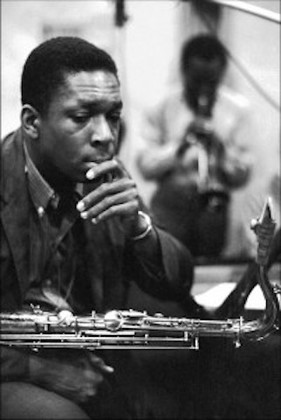To John Coltrane's quartet mates in 1963, his composition "Impressions" must have felt like an oldie. Based on Miles Davis' luxuriously nodding "So What," which had kicked off Davis' 1959 "Kind of Blue" album (featuring Coltrane), it had been reclaimed by Trane as an uptempo bristler and regularly featured in the great saxist's live performances since '61.
Coltrane's rediscovered studio recordings from March 6, 1963, recently released as "Both Directions at Once: The Lost Album," include four runs at "Impressions," two as a quartet with drummer Elvin Jones, bassist Jimmy Garrison and pianist McCoy Tyner, and two as a trio without Tyner. Why was Trane still messing with "Impressions" in 1963?
1) It's a fantastic and versatile tune. Its structure, based on three tightly adjacent chords, generates a thrilling tension that never lets up no matter how long it runs -- and the full version from the 1963 Newport Jazz Festival lasts a rollercoaster 22 minutes.
2) In March '63, it had never appeared on a record. Having witnessed the appreciation that greeted "Impressions" in live performance, Coltrane was not about to let the omission stand. His final label, Impulse, ultimately chose a 1961 live version from the Village Vanguard (despite some miking oddities) for the "Impressions" album, which came out four months after the "Lost" studio sessions were taped.
3) Coltrane had recorded two excellent studio takes of "Impressions" in 1962 with the same quartet -- but they weren't issued. They didn't make it onto the album called "Coltrane," either because the fledgling Impulse Records considered them too edgy, or due to concerns about whether to name Miles Davis as composer. The two takes can be heard on the expanded issue of "Coltrane" (the 1962 one, not the 1958 record of the same title).
4) Coltrane didn't want to pay Miles Davis royalties. Notorious for failing to credit the contributions of his collaborators (Bill Evans, Gil Evans, Wayne Shorter), Miles may well have done the same with "So What"/"Impressions," whose unusual patterns sound a lot more like a Coltrane exercise than a Miles sketch. The first two "Lost" takes of "Impressions" feature Tyner playing a call-and-response part that recalls the arrangement of "So What." Tellingly, Tyner sits out the last two takes, and the result virtually eliminates any resemblance of "Impressions" to its Milesian predecessor. Maybe Coltrane considered that he had paid Davis sufficient tribute by calling one of his most famous compositions "Miles' Mode."
5) The label wanted to distance Coltrane from Eric Dolphy. Although Coltrane esteemed his dear friend Dolphy, who played bass clarinet, alto sax and flute in Trane's 1961-'62 quintet, many listeners and critics weren't ready for Dolphy's scrambly, atonal improvisations. Consequently, sanctioned documentation of the prolific Coltrane-Dolphy alliance is unrepresentative, even considering 1961's "Africa Brass," which features Dolphy's arrangements. The prejudice shows up strongly in the case of "Impressions," a major Dolphy live showcase: The 1961 title cut features Dolphy on exactly one note -- the final one. Dolphy would die of undiagnosed diabetes in 1964, just when audiences were beginning to accept more extreme jazz. Coltrane followed in 1967.
* * *
As mentioned in the notes to "Both Directions at Once," Coltrane biographer Lewis Porter has searched out numerous origins for "Impressions," dating back to well before "So What." Read Porter's "Deep Dive" here.

